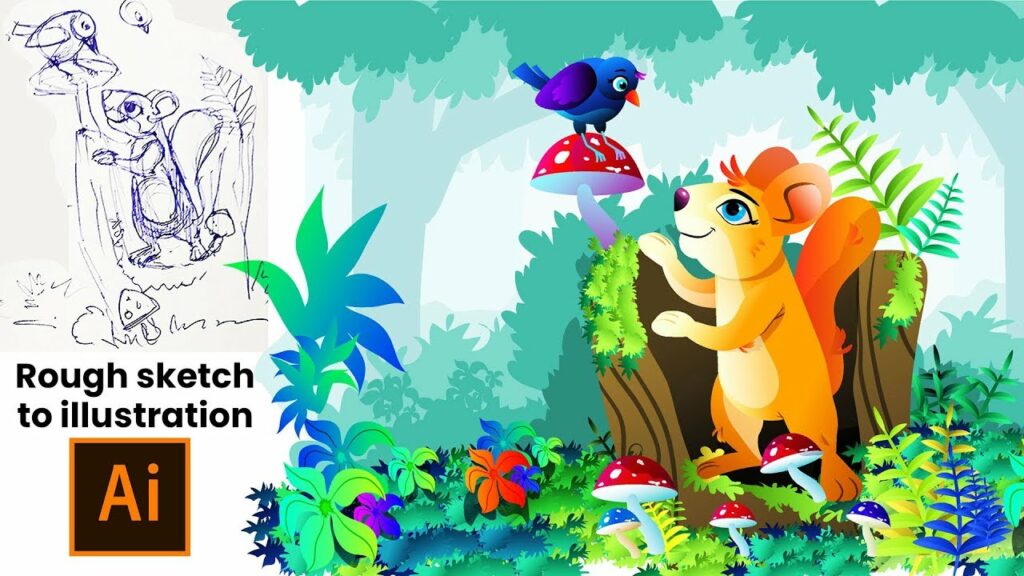A Comprehensive Guide to Crafting Engaging Vector Illustrations for Children’s Books in Adobe Illustrator

Introduction: Illustrations play a crucial role in children’s books, captivating young readers and bringing stories to life with vibrant imagery and whimsical characters. With the advent of digital illustration tools like Adobe Illustrator, artists have an unprecedented level of flexibility and creativity in crafting captivating visuals for children’s literature. In this comprehensive guide, we’ll delve into the step-by-step process of creating vector illustrations for children’s books using Adobe Illustrator, covering everything from conceptualization to final artwork.
Section 1: Understanding Children’s Book Illustration 1.1 The Importance of Illustrations: Explore the significance of illustrations in children’s books, from enhancing storytelling to fostering imagination and literacy skills. 1.2 Understanding the Target Audience: Gain insights into the preferences, interests, and developmental stages of the intended readership to tailor your illustrations effectively. 1.3 Styles and Themes: Discover popular illustration styles and themes in children’s literature, from classic hand-drawn illustrations to modern digital artwork, and how to choose the right style for your project.
Section 2: Getting Started with Adobe Illustrator 2.1 Overview of Adobe Illustrator: Familiarize yourself with the Illustrator workspace, tools, and essential features for creating vector illustrations. 2.2 Setting Up Your Document: Understand the importance of document setup, including artboard size, resolution, and color mode, tailored to your specific project requirements. 2.3 Mastering Basic Tools: Learn essential Illustrator tools such as Pen Tool, Shape Tools, Selection Tools, and Layers for creating and organizing vector artwork efficiently.
Section 3: Planning Your Illustrations 3.1 Storyboarding: Develop a storyboard or rough sketches to plan the layout, composition, and sequence of illustrations throughout the children’s book. 3.2 Character Design: Explore techniques for designing captivating characters that resonate with young readers, considering personality, expressions, and visual appeal. 3.3 Setting the Scene: Create settings and backgrounds that complement the story and evoke the desired mood, whether whimsical, fantastical, or realistic.
Section 4: Creating Vector Illustrations 4.1 Sketching and Digitizing: Begin by sketching your illustrations on paper or digitally, then use Illustrator’s drawing tools to trace and refine your sketches into clean vector artwork. 4.2 Color Palette Selection: Delve into color theory and choose a harmonious color palette that enhances the mood and atmosphere of your illustrations while appealing to children. 4.3 Adding Detail and Texture: Experiment with adding details, textures, and visual elements to enrich your illustrations, using Illustrator’s tools and effects creatively.
Section 5: Advanced Techniques and Effects 5.1 Using Brushes and Patterns: Explore Illustrator’s brush and pattern tools to add depth, texture, and visual interest to your illustrations, whether for fur, foliage, or intricate patterns. 5.2 Creating Depth and Perspective: Master techniques for creating depth and perspective in your illustrations, such as overlapping elements, varying sizes, and atmospheric perspective. 5.3 Incorporating Typography: Integrate text seamlessly into your illustrations, experimenting with typography styles, layouts, and effects to enhance storytelling and readability.
Section 6: Finalizing and Exporting Your Illustrations 6.1 Reviewing and Refining: Conduct thorough reviews of your illustrations, fine-tuning details, and making necessary revisions to ensure they align with the story and vision. 6.2 Exporting Files for Print and Digital Publishing: Prepare your illustrations for print or digital publishing by exporting them in the appropriate file formats and resolutions, considering factors like color profiles and image resolution.
Section 7: Collaboration and Feedback 7.1 Working with Authors and Publishers: Collaborate effectively with authors, publishers, and editors throughout the illustration process, ensuring your artwork aligns with the overall vision and narrative of the book. 7.2 Seeking Feedback: Solicit feedback from peers, mentors, and target readers to gain valuable insights and refine your illustrations further, ensuring they resonate with the intended audience.
Conclusion: Creating vector illustrations for children’s books in Adobe Illustrator offers artists a unique opportunity to ignite imagination, evoke emotion, and inspire young minds through the power of visual storytelling. By mastering the techniques and workflows outlined in this guide, you’ll be well-equipped to craft illustrations that captivate and delight young readers, enriching their reading experience and fostering a lifelong love of books. So, unleash your creativity, embrace the magic of storytelling, and embark on your journey to create enchanting illustrations that leave a lasting impression on generations to come.




